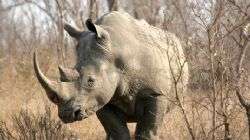In Africa hundreds of rhinos are shot or immobilised by poachers every year to supply ground up horn for the Asian medicine market. It is reputed to make men virile and treat anything from stomach ache to cancer - all just a myth.
South Africa has more rhinos than most other African countries because conservation and breeding have been more successful there. Consequently it has become a major target of the poaching syndicates and many of the rhinos are slaughtered and maimed. Their horns are hacked off - usually while still alive, leaving the injured animals to die.
Many of these rhinos are too badly maimed to survive but a group of vets has taken on the often heart-breaking task of trying to rescue and treat the animals that are not killed.
Although many do not charge for this, the costs of immobilising, testing and treating these animals is still enormous requiring helicopters and trucks as well as large quantities of expensive drugs.
Thousands of miles away from this rhino bloodbath veterinary pathologist Professor Fred Reyers, from the School of Life Sciences, University of Lincoln (UK), has been interpreting laboratory blood analysis data, sent to him electronically, to guide the vets who are treating the badly injured survivors.
He said: "Poachers use two approaches: shooting the rhino, with the intention of killing which requires marksmanship and a heavy calibre rifle. Many rhino are just stunned and/or wounded sufficiently to make it possible to saw or hack the horn off. They often have serious shrapnel injuries which tend to become infected and, if left lying on one side for several hours, are disposed to muscles on the lower side dying off because the sheer mass of the animal prevents blood flow. The second approach is the use of an immobilising dart gun - however the poacher does not give an antidote.
"The septic bullet tracts, septic horn-removal lesions and dying muscles all contribute to sepsis and this can lead to secondary damage to vital organs, like the kidney, lung and liver. These syndromes are well recognised in car crash victims, explosion injuries, battlefield wounded and burn patients. The actual lesions are almost impossible to assess accurately from the outside. So, to get an idea of how serious and/or advanced these injuries are and the resulting problems, we rely on measuring a number of blood parameters that reveal the extent and stage of inflammation and organ failure. Based on the interpretation of these blood tests, the attending veterinarian can adjust the treatment protocol."
Prof Reyers works closely with South Africa's top rhino vet Dr William Fowlds, trustee for Chipembere Rhino Foundation in South Africa.
Dr Fowlds travels all over South Africa attending to the rhino who have survived a poaching attack and helping other wildlife vets manage these cases.
He said: "This year alone we have lost nearly 400 rhino. Most of the poaching occurs in the northern Kruger National Park, a park the size of Israel. The park borders on Mozambique and we have a deluge of poachers crossing the river to get to our rhino. We have trained rangers who put their lives at risk, for very little salary. But there are also corrupt rangers that are part of the problem.
"I count myself truly blessed to be able to live my dream as a wildlife vet in a part of Africa that satisfies my senses and fills my soul. One of my many privileges is that I get to work with rhino in the wild. These living dinosaurs are truly iconic symbols of our successes and failures as custodians of this planet. The current rhino situation is a dying testimony of our conservation efforts."
More information: rhinolecture.eventbrite.co.uk/
Provided by University of Lincoln
























